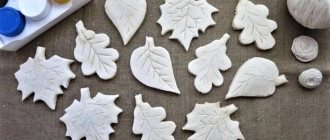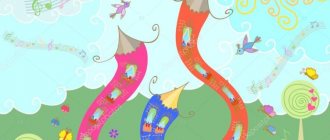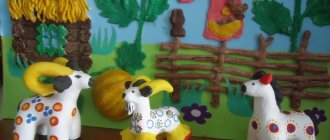Lesson summary: “Telling a story based on a set of toys”
Lesson summary: “Making a story based on a set of toys”
Developed by: Andrianova S.G.
Target:
teach children to compose a story to compose a plot story, choosing appropriate characters (toys) for it.
Tasks:
Educational:
develop the ability to compose a story using a set of toys, give descriptions and characteristics of characters, introduce dialogue into the story, learn to select definitions for given words, practice composing sentences from a set of words, independently come up with sentences of two or three words.
Educational:
continue to develop vocabulary, develop attention, memory, imagination, initiative.
Educational:
continue to cultivate a caring attitude towards the environment.
Material:
Toys: doll, bunny, kitten, puppy, bear, Christmas tree; pictures: owl, piglet, baby elephant, puppy, goldfinch, brush.
Progress of the lesson:
The teacher draws the children's attention to the toys on his table. He asks questions about each toy (What kind of doll (girl)? – description of appearance. What is her character like? – listing of character traits. What is the girl’s name?)
- Now write a story about a girl. The girl went into the forest. Who did she meet? (Bunny, bear cub.) What happened next, you will tell yourself.
- And if the girl didn’t go into the forest, who could she?! meet? (Kitten, puppy.)
– When you tell the story, take these toys and show what you came up with about them. Think about what the girl was talking about with the animals. What day was it?
The teacher suggests that several children unite in a group for storytelling. He asks: “What do you need to agree on?” (Who will talk about what, who will start the story, etc.)
Each child takes a toy, the children agree on what they will talk about. The rest listen to the story, come up with a title for it and give a rating.
Physical education minute
The teacher addresses the group:
- Let six children come to me now. They will be different words.
The teacher tells each child what word he is! After that, he checks how everyone remembers the words. A set of words: kitten, girl, fun, fast, runs, jumps.
The teacher explains the task:
– From these words you can make various sentences, about a girl or about a kitten. The sentence should consist of two or three words. Whoever comes up with a proposal will raise their hand. You shouldn’t say in advance what the sentence is - you need to arrange the words in order, and then “read”.
The child comes to the table and, without saying words, makes a sentence.
“Now tell me what sentence you came up with,” the teacher suggests. (The child names the sentence.) Let's check if you put the words correctly. Words, name yourself in order (this way, the correspondence of the sentence named by the child with the one he made from “living words” is checked).
Tasks:
1. Discuss with parents the problem of the importance of children’s speech development;
2. Show the possibility of developing coherent speech through storytelling using a toy at home;
3. Stimulate parents’ interest in using the possibilities of gaming activities to communicate with their own child.
Preparatory work: preparing a memo for parents, reflection questionnaires, presentations
Progress:
Parents sit in a circle on chairs
1. Opening remarks
— Hello, dear parents, how great it is that we have so many caring fathers and mothers who are interested in the lives of their children, and want to learn as much as possible about their development and help them grow harmoniously.
Before moving on to the topic of our meeting, I suggest getting to know each other. Pass the ball around, say your name, tell us what kind of person you are now, and what expectations you came with.
2. Main part
Speech development is the most important condition for a child’s success in school. And the question of the problem of developing coherent speech has always been one of the most pressing. From my experience and that of my colleagues, it is clear how difficult it is for children to master free speech.
Small droplets form large bodies of water. Composing a story is the same small drops that will help you arrive at a large reservoir of developed coherent speech.
It is with the toy that the child interacts from birth. And it becomes one of the most accessible means through which you can communicate with a child, provoke him into dialogue, and then into independent expression.
And today we will talk about how, at home, you yourself can easily and affordably develop high-quality, grammatically coherent speech in a playful way.
A statement about a toy affects:
• on sensory perception, development of observation skills;
• creative thinking and imagination;
• consolidation and activation of the dictionary, or serves as a source of new words;
• positive emotions and desire to speak out;
What toys can be used?
• didactic (matryoshka dolls, turrets, pyramids, barrels);
• plot (figurative): dolls, cars, animals, dishes, furniture, transport;
• ready-made sets of toys, united by one content: herd, zoo, poultry yard;
• sets compiled by the teacher or children - boy, girl, sleigh, dog; girl, house, chicken, cat; hare and dog.
Since each new toy brings joy, pleasure, and a desire to talk about it in the child, for communication you need to use new or somewhat updated familiar toys (a doll in a new dress, apron, hat; a bear sitting in a car). This will cause the child to have new thoughts, an emotional attitude towards the toy, and a speech reaction.
There are several types of storytelling based on a toy.
1. Description of a toy - a coherent, consistent description of the appearance of the toy, sometimes with the addition of the child’s personal attitude towards it, or a description of the actions and lifestyle of the living creature depicted in the toy
2. Plot storytelling (narration)
3. A story about a set of toys - a coherent, sequential story about a group of toys, most often accompanied by play actions. Its compilation is made easier by the fact that the child talks about the actions that he himself performs. His speech is based on the activity of a number of analyzers;
4. A story about a separate toy is a coherent, sequential story about the imaginary actions and adventures of one character - this toy. This is the most difficult type of storytelling. The toy only defines the main character, and the children themselves come up with images of other characters, actions and situations based on creative imagination and their own experience.
What is the sequence of the conversation about the toy.
Younger age (3-4 years) In early preschool age, the first task is to teach children to concentrate when looking at toys and objects, then to teach them to answer questions based on their description.
Since every toy evokes joy, pleasure, and a desire to talk about it in a child, for descriptions you need to use new or somewhat updated toys (a doll in new clothes; a bear sitting in a store).
You can start by asking a riddle, a poem, a nursery rhyme about a toy (without showing it), and come up with a story about how it got here.
Mane on the neck, tail like a pipe, bangs between the ears (horse);
The bear came from the forest and brought honey from the bees especially for you.
Together with your baby, look at the toy and let him touch it. Ask him questions about the toy. What kind of cat do you have? What's on the cat's head? What is this?
Then the adult himself summarizes all the answers into a single statement. A cat came to us. She has ears on her head, big eyes, and a mustache. The cat also has a long tail. She laps up the milk and meows: meow! Meow!
In the next step, let the child himself repeat the adult’s description.
Collaborative writing of a description. The adult starts, and the child continues
This is (kitten). It is small). The kitten loves (milk). Etc.
In the end, you can come up with a game with this item. Take them to visit other toys. Fantasize about adventures that could happen to him, etc.
Middle age (4 -6 years)
At this age, it is important to lay the foundation for developing the ability to independently describe toys.
You can start by asking a riddle, a poem, a nursery rhyme about a toy (without showing it), and come up with a story about how it got here.
Looking at a toy. Specify the features of the appearance and lifestyle of a living creature in a toy; comparisons and definitions are selected. Shy hare, cautious sly fox
Come up with a plan for your child to use to talk about the subject. To do this, it is important to ask questions in a certain order. Who is this? What is he like? What does he do (can he do)? How do you feel about him? And so on.
Here, it is also possible that you and your child have 2 similar toys (dolls of different sizes and in different clothes, 2 different dogs, etc.) You talk about your toy according to plan, and your child, at the same time, about yours.
Ask the child to independently talk about the toy, according to the same plan, without your help.
Older age (6-7 years)
At this age, the child is already composing a story on his own; the adult only sets the plan and scheme for the retelling. But it’s still important not to omit the gaming moment and interest.
Play up the appearance of the toy. For example, the postman brought a parcel. Then you can ask a riddle.
Offer to examine the toy carefully, paying attention to its appearance and qualities - color, shape, size, material.
And then, using the same scheme, ask them to tell you about this toy.
To make the retelling easier, you can draw a diagram for the child with the symbolism of the micro-topics of the description. A sheet of cardboard 45 by 30 cm is divided into squares according to the number of characteristics of the objects. A symbol is placed in each square to tell children the sequence of presentation.
At the end, you can talk about your attitude towards this toy, ask him to make a riddle about it for another family member or friend, based on the signs.
With this toy, you can later come up with a story and play it out, so that interest in it does not disappear.
During the retelling, you can suggest words, supplement, encourage with a smile. It is important to monitor the correctness of the statement, literacy (correlation of words in cases, numbers, etc.).
And now I suggest you choose your age and try to beat the situation with the toy yourself. You will need to compose a story based on this particular toy, following the algorithm.
Parents are divided into several teams. Each team has its own toy.
Thank you for such productive work, I hope that this information will be useful to you and you will definitely put it into practice at home!
Now I will give you instructions on writing stories.
Do you have any questions for me?
To sum up, I ask you to fill out questionnaires with reflective questions.
Communicative. Speech development. Compiling a story based on a set of toys “An Incident in the Forest”
You will need: toys: a bear, a bunny, a hedgehog, a beetle, a Christmas tree, a model of a tree without leaves, a stump and leaves. Hedgehog, hare, bear. (if there are no such toys, you can replace them with those that are available)
Read it and picture it to your child. One day a bear cub, a bunny and a hedgehog were playing in a clearing. Suddenly they heard someone buzzing: “w-w-w.” The animals got scared and hid. The bear cub hid behind the tree, the hedgehog hid under the tree, and the little hare jumped onto a stump.
Ask your child questions. Where did the bear cub hide? (for the Christmas tree). Hedgehog? (under the Christmas tree) Where did the little bunny jump? (on a stump).
A hedgehog, a hare and a bear came to the clearing, looking for their cubs. Ask: Who is the bear, hare, or hedgehog looking for? Where did the bear cub hide? Bunny? Hedgehog?
Ask why the cubs hid? Who were the animals afraid of? Do you know who was buzzing? Where do you think the beetle is? Where can he hide? The beetle hid in the grass. Where's the bug? How does a beetle buzz? What is the sound of a beetle buzzing?
Tell your child that the beetle is in trouble: his favorite tree is dying. Do you want to help him?
To help the tree, you need to name words with the sound Z. When the child names words with the sound Z, attach a leaf to the tree. The tree "comes to life."
Play the game. WHO MOVES HOW The green grasshopper jumps, and the striped bee ... (flies). The cockchafer crawls, and the little grasshopper...(jumps). The big-eyed dragonfly flies, and the hardworking ant ... (crawls). An annoying fly flies, but a beautiful butterfly...(flutters). A small mosquito flies, and a big grasshopper... The red ant crawls, and the transparent-winged dragonfly…. A strong ant crawls, and a carefree grasshopper….
Constructive-model activity “Houses for bees” (from a wooden construction set)
Give your child a riddle.
Garden worker
Honey belt.
Buzzed like a saw
Striped... (Bee)
Ask where bees live? Invite your child to watch the video.
https://yandex.ru/video/preview/?filmId=8465358948047749415&text=cartoon++for+children+where+bees+live
Invite your child to build a house for a bee.
Cognitive and research. FEMP Account consolidation.
Invite your child to watch an educational video.
https://yandex.ru/video/preview/?filmId=15678203388468048037&text=+video+for+children+on+math+counting+insects
Count the dots and find the number.
Invite your child to look at a picture of a ladybug. How many dots does each ladybug have, you ask? Let the child find the appropriate number.
Productive. Decorative drawing “Beauty Butterfly”
Give your child a riddle.
Not a bird, but with wings,
It's not a bee, it flies.
Bright, elegant
It flutters over the flowers. (Butterfly)
Invite your child to look at the butterflies. What kind of things are they...
Ask your child if he would like to draw his own butterfly. Consider the diagram of drawing an insect.





